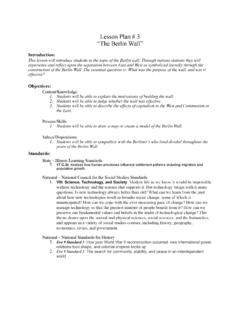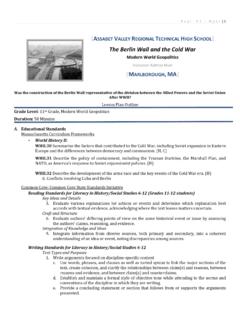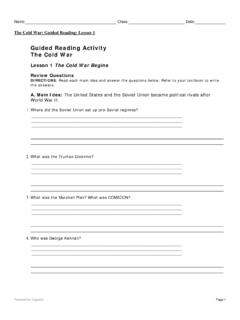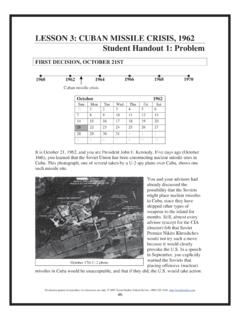Transcription of Trends Patterns Migration Push/ Effects Factors
1 6th Grade Social Studies: World Geography and Global Issues SS60305. Unit 3: Population and Migration Lesson 5. Graphic Organizer Trends Patterns Migration Push/. Pull Effects Factors Michigan Citizenship Collaborative Curriculum Page 1 of 14. Oakland Schools November 20, 2012. 6th Grade Social Studies: World Geography and Global Issues SS60305. Unit 3: Population and Migration Lesson 5. Big Idea Card Big Ideas of the Lesson 5, Unit 1. The Migration of people to new places has been an important part of history since the earliest people began to migrate out of Africa. Population growth is impacted by the Migration of people. Push Factors such as conflict or lack of jobs push people out of the places where they live. Pull Factors such as job opportunities or freedom pull people to new places. Michigan Citizenship Collaborative Curriculum Page 2 of 14. Oakland Schools November 20, 2012. 6th Grade Social Studies: World Geography and Global Issues SS60305.
2 Unit 3: Population and Migration Lesson 5. Word Cards 18 19. immigration emigration the process of entering one country to the process of leaving one country to take up permanent or semi-permanent take up permanent or semi-permanent residence residence Example: Immigration results in population Example: Emigration results in population growth in a country. loss in a country. (SS060305) (SS060305). 20 21. net Migration push Factors the net effect of immigration and Factors that push people emigration on an area's population in a out of one place to another place given time period Example: Conflict and a lack of jobs serve as Example: Net Migration is expressed as an push Factors . increase or a decrease. (SS060305). (SS060305). 22 23. pull Factors refugee Factors that pull, or a person who has been attract, people to move to a place forced to leave his/her country in order to escape Example: Jobs and a higher standard of living war, persecution or natural disaster serve as pull Factors .
3 Example: Refugees often have to flee their (SS060305). country with few of their belongings. (SS060305). Michigan Citizenship Collaborative Curriculum Page 3 of 14. Oakland Schools November 20, 2012. 6th Grade Social Studies: World Geography and Global Issues SS60305. Unit 3: Population and Migration Lesson 5. Net Migration Data Net Migration Net Data for Selected Countries Rate per Migration Regional Data Rate per 1000. 1000 Africa -1. World - Nigeria 0. More developed 2 Senegal -2. Less developed -1 Burundi 4. Less developed (excluding China) -1 Somalia -12. Least Developed -1 South Africa 2. Africa -1 Americas 0. Northern Africa -1 Canada 7. Western Africa -1 United States 2. Eastern Africa -1 El Salvador -8. Middle Africa 0 Mexico -3. Southern Africa 2 Brazil 0. Americas 0 Asia 0. Northern America ( and Canada) 3 Bahrain 17. Central America -3 Qatar 19. Caribbean -4 Syria -1. South America 0 Bangladesh -3. Asia 0 China 0. Asia (excl. China) 0 Europe 2.
4 Western Asia 1 Ireland -7. South Central Asia -1 Lithuania -12. Southeast Asia 0 Switzerland 8. East Asia 0 Germany 3. Europe 2 Spain -2. Northern Europe 3 Oceania 4. Western Europe 3 Australia 8. Eastern Europe 2 Samoa -17. Southern Europe 2 New Zealand 0. Oceania 4. Source: 2012 World Population Data Sheet. Population Reference Bureau. 20 November 2012. < >. Michigan Citizenship Collaborative Curriculum Page 4 of 14. Oakland Schools November 20, 2012. 6th Grade Social Studies: World Geography and Global Issues SS60305. Unit 3: Population and Migration Lesson 5. Analyzing Data Compare the regional data for the world. What conclusion can you draw from the data? Compare the regional data for continents. What are two conclusions you can draw from the data? Compare the country data. What are three conclusions you can draw from the data? What do you think are some Factors that cause such differences in the country data? Michigan Citizenship Collaborative Curriculum Page 5 of 14.
5 Oakland Schools November 20, 2012. 6th Grade Social Studies: World Geography and Global Issues SS60305. Unit 3: Population and Migration Lesson 5. International Migration : Facing the Challenge International Migration people moving across national borders is a global challenge for the 21st century. More than 190 nation-states issue their own passports and visas and regulate who can cross their borders and stay. At least 214 million people were living outside their country of birth in 2012, up from an estimated 120 million in 1990. However, most of the world's 7 billion people never cross a national border. Most people live and die near their place of birth. Those who cross national borders usually move to nearby countries. For example, people from Mexico to the United States, or from Turkey to Germany. The largest flow of migrants is from less developed to more developed countries. Large flows of people also move from one industrialized country to another, from Canada to the United States, for example.
6 People move in much smaller flows from more developed to less developed countries, such as people from Japan who work in or retire to Thailand. The international community believes that international Migration should be voluntary, and has tried to minimize forced Migration , whether motivated by persecution or economic deprivation at home. The United Nation's 1948 Universal Declaration of Human Rights asserts that everyone has the right to leave any country, including his own, and to return to his country. However, the right to emigrate does not give migrants a right to immigrate; most migrants are not welcomed unconditionally into the countries to which they move. Explain the following phrase: The right to emigrate does not give migrants the right to immigrate.. Migration in Perspective As long as humans have wandered in search of food, they have migrated from place to place. But international Migration is a relatively recent development. Only in the early 20th century was the system of nation-states, passports, and visas developed to regulate the flow of people across borders.
7 International Migration is the exception, not the rule. Most people do not want to move away from family and friends. In addition, governments try to regulate border crossings. But international Migration is likely to increase in the 21st century because of persistent demographic and economic inequalities and because many advances in communications and transportation facilitate mobility. What might be an economic inequality' that would cause someone to leave their own country and migrate to another country? Michigan Citizenship Collaborative Curriculum Page 6 of 14. Oakland Schools November 20, 2012. 6th Grade Social Studies: World Geography and Global Issues SS60305. Unit 3: Population and Migration Lesson 5. Most countries discourage immigration they do not welcome the arrival of foreigners who wish to settle and become naturalized citizens. Some also discourage emigration. This was the situation in communist nations as symbolized by the Berlin Wall, which was used to deter crossing from East to West Germany between 1961 and 1989.
8 Today, North Korea continues to prevent its citizens from leaving the country. Five major countries plan for the arrival of immigrants: the United States, Canada, Australia, New Zealand, and Israel. However, the number of newcomers arriving in these countries each year exceeds the number planned, suggesting that many are temporary visitors or unauthorized foreigners who find ways to settle rather than newcomers who enter as potential new citizens. Perspectives on the rising number of migrants can be framed by two extremes. At one extreme, organizations ranging from the Catholic Church to the World Bank have called for more Migration , arguing that people should not be confined to their countries of birth by national borders and that more Migration would speed economic growth and development in both sending and receiving countries. At the other extreme, in virtually every industrialized country, organizations are demanding sharp reductions in immigration.
9 In the United States, the Federation for American Immigration Reform (FAIR) argues that unskilled newcomers hurt low-skilled workers, have negative environmental Effects , and threaten established cultural values. Political parties in many European countries have called for reducing immigration at one time or another. Describe the two extremes' regarding the issue of Migration . The first step toward making Migration manageable is to understand why people migrate. Most people do not want to cross national borders, and even though the number of migrants is at an all-time high, international Migration is still low relative to the 97 percent of the world's residents who did not migrate. Furthermore, economic growth can turn emigration nations into destinations for migrants, as it did for Ireland, Italy, and Korea. The challenge is to manage Migration by reducing the differences that encourage people to cross borders. Managing Migration : The Global Challenge.
10 Population Reference Bureau. 20 November 2012. < >. Michigan Citizenship Collaborative Curriculum Page 7 of 14. Oakland Schools November 20, 2012. 6th Grade Social Studies: World Geography and Global Issues SS60305. Unit 3: Population and Migration Lesson 5. Sorting Cards 1. The 1956 Hungarian Revolution failed and 2. led to the emigration of 200,000 "56-ers" Many people from northern European countries are fleeing persecution after the revolution, retiring in southern European countries where the 40,000 of whom found their way to the United climate is warmer. States. 3. 4. From 1955 until 1973, over one million guest In the 1990s many people from Afghanistan moved workers arrived in the Federal Republic of to neighboring countries because of serious Germany, mostly from Italy, Spain, and droughts. Turkey. 6. 5. In 1947 the Indian subcontinent was divided along Between 1960 and 1996, when the civil war religious lines into two countries. India, which was in Guatemala formally ended, over 400,000.





